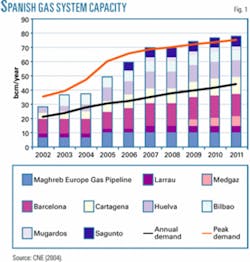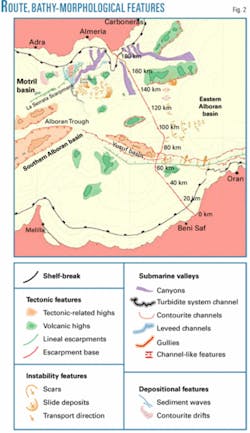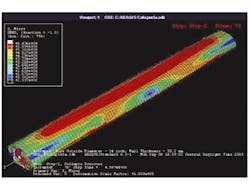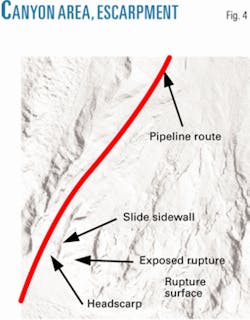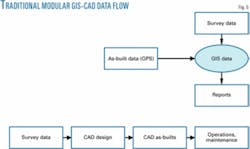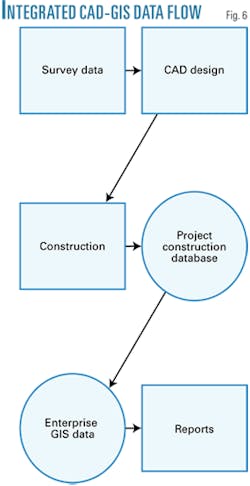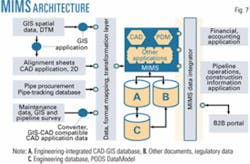The planned implementation of the Medgaz Integrity Management System (MIMS) is expected to offer savings of 10-20% on pipeline maintenance through guaranteed up-time and risk reduction in operating the deepwater pipeline system.
The ultradeepwater Medgaz pipeline will run 210 km across the Alboran Sea in water 2,160 m deep, connecting the Algerian gas network to the Spanish gas grid.
The Medgaz system also includes a compression station at the Algerian shoreline and a gas reception terminal at Almería, Spain.
This article discusses the architecture and implementation of MIMS.
The design of this high-pressure gas transmission system required careful assessment of the integrity-management challenges posed by the deepwater environment and cross-border operations. Detailed mapping of the seabed terrain provided the geo-spatial database that will assist integration of the as-laid pipe database generated during the construction phase.
The integrated database will also provide reference information for periodic internal and external inspections and condition monitoring.
Coupled with the gas terminal plant maintenance system, the MIMS system will enable the Medgaz line to run as a low downtime, highly efficient gas transmission operation.
Medgaz is currently evaluating long-lead items and EPIC tenders, with first gas scheduled for early 2009.
Medgaz
The Medgaz project consists of the following segments:
- An onshore compressor station at Beni Saf, Algeria (BSCS).
- A deepwater 24-in. OD pipeline across the Alboran sea, 2,155 m deep and 210 km long.
- A reception terminal near Almería, Spain (OPRT).
Phase 1 of the project will see construction of one 8 billion cu m/year pipeline. Construction of a parallel 24-in. second line could double capacity in the future.
Economic rationale
The economic rationale for the project derives from prospects for continued growth of the region.
- Iberia’s fast growing energy market poses challenges to existing infrastructure. Spanish gas consumption grew to 28.3 billion cu m/year in 2004 from 21.4 billion cu m/year in 2002. By 2011, annual demand will exceed 44 billion cu m/year (Fig. 1).
- Manufacturing growth and the need to switch to fuels better able to meet Kyoto Protocol targets are increasing gas demand at an 18%/year.
- Delays in increasing infrastructure capacity could harm the short and medium-term development of the Iberian energy market as well as the growth potential of the economy.
- Sedigas says that gas demand from combined-cycle gas turbines increased by 66% in 2005 compared to 2004 due to start-up of a number of gas-fuelled power stations.
- Spain depends on imports for 99.6% of its gas, of which 65% is LNG and 35% pipeline gas. LNG costs significantly more than pipeline gas due to liquefaction, sea transportation, and re-gasification expenses.
Independent energy consultants have extensively studied the long-run marginal cost (excluding producing-country royalty) for potential gas supply to Spain. The studies show the Medgaz pipeline to be the lowest cost supply option.
Integrity management
Medgaz interprets pipeline-integrity management as a cohesive business strategy to ensure defect-free long-term performance of the transportation system.
The technical challenges of effective integrity management have three distinct phases:
- Design.
- Construction.
- Operation.
The following subsections describe the approach adopted by Medgaz to deliver integrity of the planned system.
Pipeline design
Ensuring design integrity requires a structured approach, taking the following elements into account:
- Routing alternatives.
- Geophysical and geohazard characterization of the seabed and underlying strata.
- In-service loading.
- Construction-installation assessments.
The routing alternatives are, in turn, assessed with the following factors:
- Minimization of environmental impact.
- Protection of marine flora and fauna on both the offshore and onshore sections of the line.
- Avoidance of natural obstacles that exist along the route.
- Low geological and geotechnical risks.
- Minimization of free-span risks.
Medgaz developed a geographical information system (GIS) database of all survey data to ensure integrity and consistency of bathymetry charts, geophysical and geological characteristics, and flora-fauna data. Fig. 2 shows the general bathymorphology of the pipeline route.
Geohazard evaluations
Known characteristics of the pipeline route and information available from surveys provided the basis for detailed geohazard assessments performed to ensure the proposed pipeline route avoided significant geological and seismic risks.
These assessments included:
- Geophysical interpretation.
- Probabilistic Seismic Hazard Assessment (PSHA).
- Slope stability assessment.
- Probabilistic fault displacement hazard analysis.
- Numerical run-out modeling.
Calculations assessed the integrity of the pipeline under geohazard-type extreme failure events. The events covered included:
- Fault slip-reverse, normal, and strike slip fault movement.
- Slope failure-failure of the steeper slopes resulting in loss of support to the pipeline.
- Mass sediment movements (turbidity flow and mud slide events)-impact of a fast-moving dense flow on the pipeline.
These calculations sought to verify the integrity of the pipeline, thereby ensuring pipeline survival during extreme events.
Design code
Medgaz pipeline’s design complies with DNV OS-F101, which lays down detailed guidelines for assessing loads and response of the pipeline for design, installation, in-service, and extreme load scenarios. Extensive material and prototype testing demonstrated adequate design safety margins for the various loading scenarios.
Fig. 3 shows a typical output from finite element analyses.
Fig. 4 illustrates the technical problems surrounding safe installation of a pipeline in a deepwater environment.
Construction integrity
Managing construction integrity requires a host of complementary information technology systems to ensure quality control of the pipeline construction process.
Fig. 5 represents the traditional approach undertaken to oversee construction integrity. The traditional systems, however, have posed the following problems:
- Disjointed survey information and CAD information, resulting in lack of simulation and accuracy.
- Requirement of manual correlation of data at all stages; planning, construction, and maintenance.
- Lack of centralized data resulting in suboptimal collaboration between survey, engineering, construction, and repair-maintenance functions.
- Lack of project data flow between various applications.
Integrated CAD-GIS
To ensure efficient utilization of design data and associated GIS database, Medgaz is developing an integrated CAD-GIS system. Fig. 6 depicts the logic flow of the integrated GIS-CAD system.
null
MIMS
MIMS is the central knowledge-based information and decision-making system Medgaz will use for the construction and operation phases of the project. Fig. 7 depicts the proposed Medgaz integrated dataflow from design to construction and from construction to operation.
This data model will support efficient operations and risk management for the Medgaz transportation system.
Long-term integrity
MIMS’s data model will be able to capture and present different views of pipeline data acquired during all phases of the project. This ensures that the Medgaz operations team can use MIMS as a holistic tool to plan inspection strategies and populate the MIMS database with new data acquired from internal and external pipeline survey campaigns to maximize up-time of the pipeline.
Fig. 8 shows the central role of MIMS, depicting the overall IT architecture.
Based on a presentation to World Gas Conference, June 5-9, 2006, Amsterdam.
The author
Jay Chaudhuri ([email protected]) is project manager for Medgaz SA, Madrid, which will construct and operate the new gas pipeline linking Algeria and Spain. Chaudhuri has 24 years of oil and gas industry asset development and deepwater project experience. He previously served as development manager for London & Scottish Marine Oil Co.’s (LASMO) Algerian asset portfolio (1997-2001). Before that, he worked as an engineer on various offshore projects. He holds a degree in naval architecture from Indian Institute of Technology, Kharagpur, India, and an MSc from Strathclyde University, Glasgow. Chaudhuri is a chartered engineer and a member of SPE and of the Royal Institution of Naval Architects.
